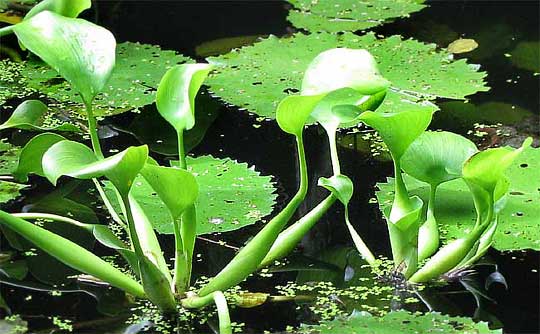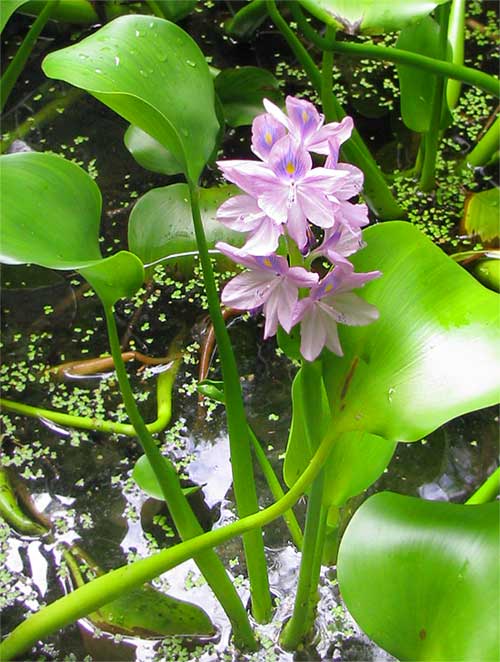Excerpts from Jim Conrad's
Naturalist Newsletter
from the October 6, 2008 Newsletter written in Sabacché; ~N20.66°, ~w89.37°, elev. ~10m (~63ft); issued in Mérida, Yucatán, MÉXICO
CENOTE WATER-HYACINTHS
Most of the water surface-area in the abovementioned Black Vulture Cenote is covered with a mass of Water-Hyacinths, EICHHORNIA CRASSIPES, of the aquatic Pickerel-Weed Family, the Pontederiaceae. The plants form a tangle about knee deep atop the water so dense that you can't see the water below them -- nothing but a solid, green mass of leaves and stems. Sometimes Water-Hyacinths, native to tropical and subtropical America, obstruct navigation by choking rivers, streams and canals. One just wonders how the species ever got established in this isolated cenote surrounded on all sides by arid scrub.
At the edge of the floating thicket a few plants were widely spaced enough for you to see the Water-Hyacinth's graceful form and the inflated leaf-petioles enabling them to float atop water, as shown below:

A few of those outer plants also were flowering, seen below:

The blossoms were pretty enough for a close-up:

Rosy-lilac Water-Hyacinth flowers always bear that blue spot on the upper perianth lobe, with a yellow center-spot. I use the word "perianth" because in this monocotyledonous family the calyx and corolla are merged. Instead of the flower having three sepals and three petals, it has six perianth lobes, technically referred to as tepals.
In the picture the stiff, pale items with hooked tips and issuing from the flowers' throats, and ending in dark, flattish items, are stamens. Especially in the flower at the left you can see a white, spherical thing curving up about midway the stamens' fuzzy filaments. The white globe is the female stigma held aloft by the curve-necked style, which leads down into the flower's tube to the ovary.
Each Water-Hyacinth blossom bears six male stamens, though we can make out only three with long, stiff, fuzzy filaments. That's because a feature of flowers in the genus Eichhornia is that the six stamens arise from the perianth tube at different spots, so that some don't extend from the corolla like the three we see. At the throat's opening you can see one or two anthers of lower stamens peeping out.
What a contrast these succulent, gaudy, elegant, cenote-bottom plants made with the tough, spiny scrub surrounding us above. Sometimes I go into cenotes and just sit, in order to not become too arid myself.